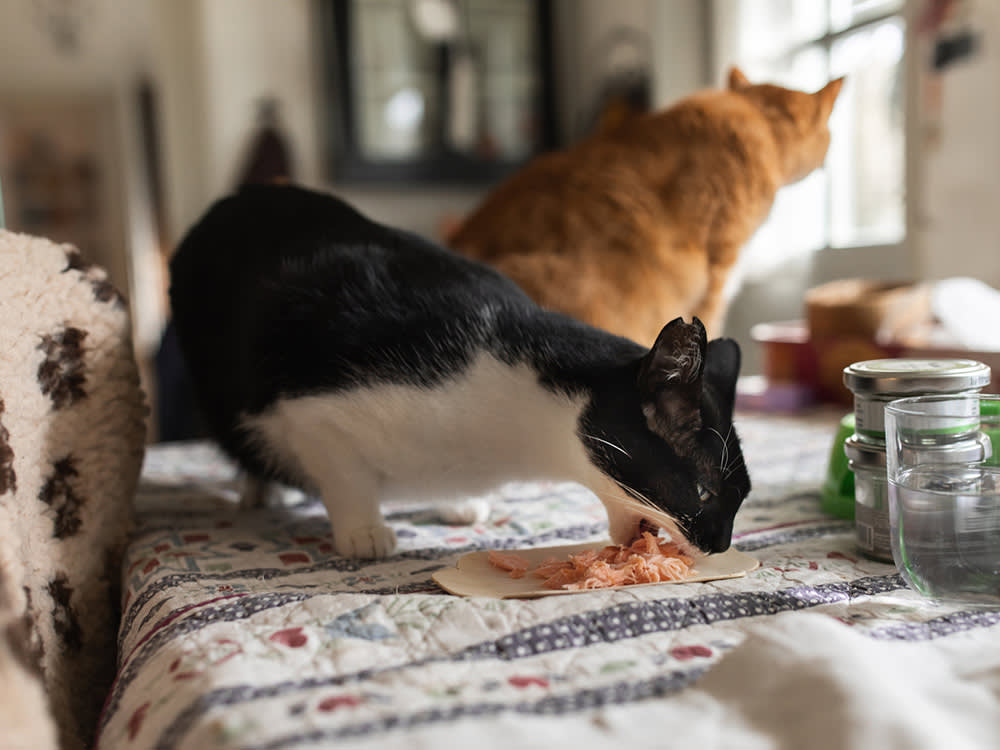Could Fish Reduce Your Pet’s Carbon Footprint? It’s Complicated
All those cartoons of cats staring longingly at fish bowls might not be so far off. A new study suggests seafood in your pets’ diet could help sustainably meet the world’s protein needs.

share article
It’s tough being a pet parent these days. We worry about our cats breaking into their automatic feedersopens in a new tab, wonder why our dogs are itchy even though it’s fallopens in a new tab, and — increasing — whether what we feed them is good for our pets and the planetopens in a new tab.
There are no farms where animals are raised just for pet food. The beef, pork, chicken, and other sources of protein used to make pet food are byproducts and co-products of factory farming. It’s no secret that the industrial-sized production of meat places a strain on our planet, sharing an estimated 14.5 percent of human-caused global greenhouse gas emissions (GHGs).
This (technically) also means that our animal companions share the burden of contributing to our collective carbon footprint. It’s not their fault — they’re all perfect. But, it’s definitely an issue that the commercial pet food industry contributes a quarter of the environmental impact of meat production, according to a 2017 UCLA studyopens in a new tab.
Climate experts worldwide have stressed the need for a more sustainableopens in a new tab global food chain. Eat more plants, and less animal protein, a 2019 Oxford study saysopens in a new tab.
A new study, published in the journal Communications Earth and Environmentopens in a new tab, suggests that seafood could help sustainably meet the world’s protein needs. But not just any seafood will do. Just like industrial farming devastates ecosystems, industrial aquaculture is linked to ocean ecosystem collapse. Every part of the ecosystem helps mitigate the climate crisis in some way. So, when creatures, plants, and other organisms start to disappear from an ecosystem, it throws things off balance and drives up the global temperature.
This highlights just how big of a role food production plays in the state of the climate crisis. To that end, how those calories are sourced matters. For humans, experts recommend eating less meat and more plant protein. But cats are carnivores by nature and while dogs can chow down on vegetables with you, they still benefit from the nutrients obtained from animal-derived protein.
There are some entrepreneurs working on making cell-cultured pet foodopens in a new tab — which is grown from real animal protein in a bioreactor instead of on a factory farm—but, it’ll likely be some time before that’s actually in your animal companion’s bowl.
According to the study, the overall environmental impact of an aquatic protein depends on the production method. Wild-caught pink salmon, sockeye salmon, and pelagic fish, as well as farmed mussels and oysters have the highest nutritional benefits with the lowest GHGs. Farmed and wild-caught shrimp and lobsters, meanwhile, had the fewest health benefits with a higher-than-average climate impact.
Overall, the study recommends skipping terrestrial protein and leaning into sustainable aquaculture. So, does this mean that this could be a way to feed our pets a healthy diet without relying on beef, pork, or chicken? The answer is: yes, fish is good for our animal companions, and in many ways.
Benefits of Fish for Cats and Dogs
It’s rich in protein.
Fish high in protein is the most important macronutrient for our animal companions, but for different reasons. “Fish is a great protein source for dogs and cats. It’s easy to digest and it’s rich in essential amino acids,” says Debra Eldredge, a veterinarian at Cat Worldopens in a new tab.
Protein is made up of organic compounds known as amino acids. Dogs require 22 amino acids, about half of which is produced by the body. The rest need to be obtained from foodopens in a new tab, such as beef or fish. In canines, amino acids help maintain healthy skin and fur, tissue repair, muscle development, and more. It also aids in immune system health and provides energy.
Unlike humans, who use carbohydrates as their primary source of energy, protein is a cat’s most important source of fuel. Like dogs and humans, cats also need protein for maintaining bodily functions and wound-healing.
It contains omega-3 fatty acids.
Both salmon and pelagic fish contain omega-3 fatty acids, which packs a lot of health benefits for both catsopens in a new tab and dogsopens in a new tab. This polyunsaturated fat provides energy, lowers inflammation, supports cardiovascular and immune system health as well as neural development, and helps fight skin allergies.
Research shows that omega-3 fatty acids may also be good for aging cats and dogs, particularly if they’re experiencing joint pain or arthritis. “Many commercial diets now include omega-3 fatty acids, but some pets will still benefit from more, especially if they have skin or joint problems,” says Dr. Eldredge.
But, you want to be mindful of where that omega 3 is coming from and to always have a chat with your vet before you change up your cat or dog’s food. “The most common way to supplement is to add some fish oil to the diet,” says Dr. Eldredge.
“For one thing, you want the fish oils to say that they are screened for heavy metals. You also need reputable sources since it is easy for fish oils to become rancid. Salmon oil is often a good choice,” she adds. In addition to that, Dr. Eldredge notes that “too much omega 3 can lead to gastrointestinal problems, clotting problems, and even cause some immune problems. You should discuss how much to supplement with your veterinarian or a veterinary nutritionist.”
This is where choosing sustainable fish for your dog becomes complicated. Per the study, certain wild-caught species of salmon are less harmful to the planet compared to beef or chicken. The pet food market, however, doesn’t default to these standards. The real challenge is getting the entire industry on board with more sustainable pet food production.
The more realistic solution may be to give your pets the occasional wild-caught fish that falls into the parameters outlined by the study—that comes with some complications that’ll be addressed below.
The Dangers of Too Much Fish
Fish may come with health benefits, but too much of it can be a bad thing.
You can’t just give your cat or dog wild-caught fish from the supermarket. Raw fish bears the risk of carrying foodborne bacteria, such as salmonella and listeria, which can make both you and your dog sick, according to the American Kennel Clubopens in a new tab. It also contains an enzyme that destroys thiamine (aka vitamin B1) that your cat needs in their diet.
To be safe, fish should be cooked and checked thoroughly for small bones before being shared with your animal companions. It’s also possible that your cat or dog may be allergic opens in a new tabto fish, Dr. Edredge adds: “Because fish is a protein, there are pets who will have food allergies or food intolerance to some types of fish.”
It’s best to monitor your animal companion for symptoms of a food allergy, including itchy skin, rashes, and digestive issues. “Still, for many pets, fish is a tasty, high-quality protein for their diet,” adds Dr. Eldredge.

Kat L. Smith
Kat L. Smith is a writer and editor based in Queens, New York. They have written for LIVEKINDLY about a wide range of topics related to sustainability, lifestyle, house plant care, and food. They share their apartment with their adopted dog, Layla, and Vivi, a one-eared cat.



